This post is all about how to make a beautiful and easy bread wreath recipe!
This easy-to-follow bread wreath recipe is not only delicious, it will also be a showstopper this holiday season!
Be ready to eat the fluffiest rolls in the world! Each pillowy bite is the right amount of salt and hints of rosemary. These scrumptious rolls can be enjoyed on their own (slathered with butter, of course) or you can place a wheel of brie in the center and top it with fresh pomegranate and drizzled honey.
If you end up with leftovers, these make ham, cheese, arugula, and mustard sandwiches that are to die for.
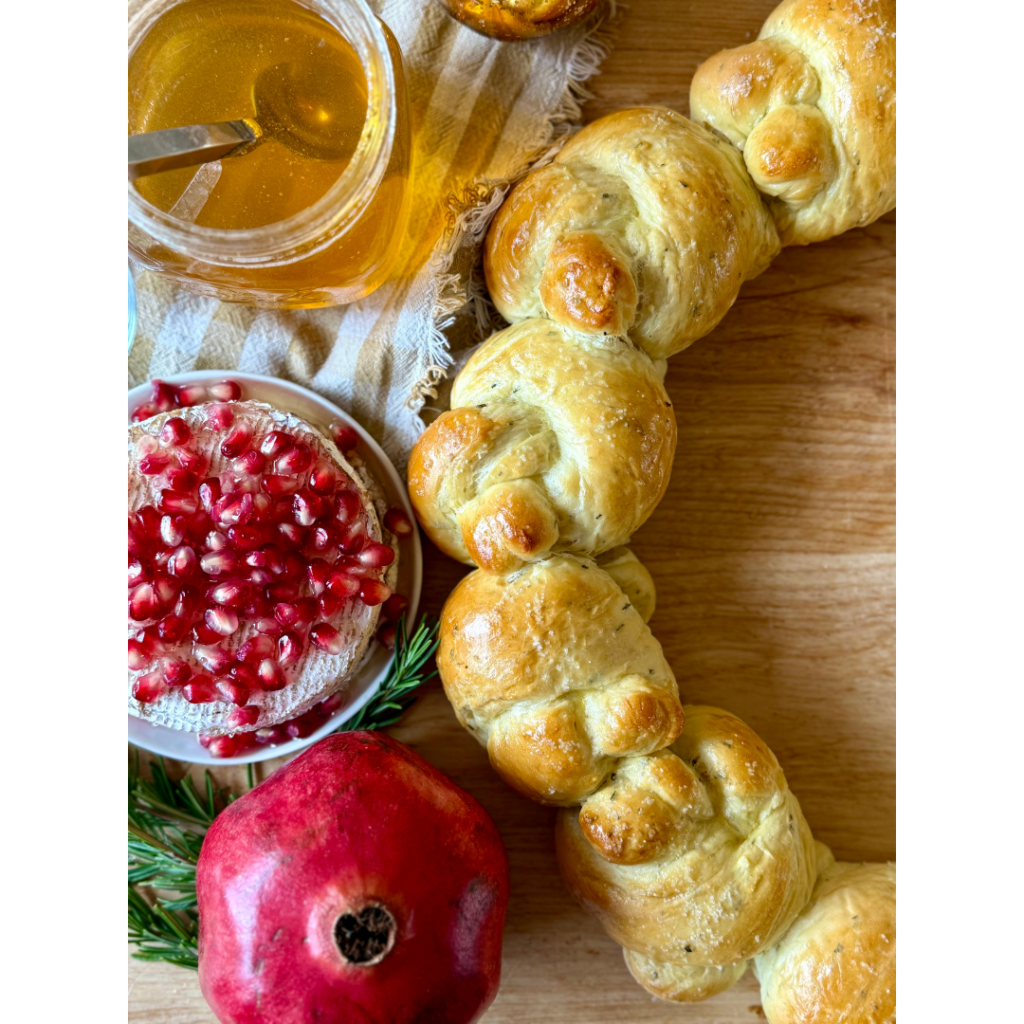
This post may include affiliate links that earn us a small commission from your purchases at no extra cost to you. You can read about it on my disclosure policy.
Table of Contents
Ways to enjoy this easy bread wreath recipe
Steps if you’re making this bread wreath by hand
Steps if you’re making this bread wreath using a bread machine
About the recipe
This recipe comes from my Aunt Jan, and I can’t remember a Thanksgiving or Christmas where this beautiful bread wreath wasn’t on the table. You can see her recipe below!
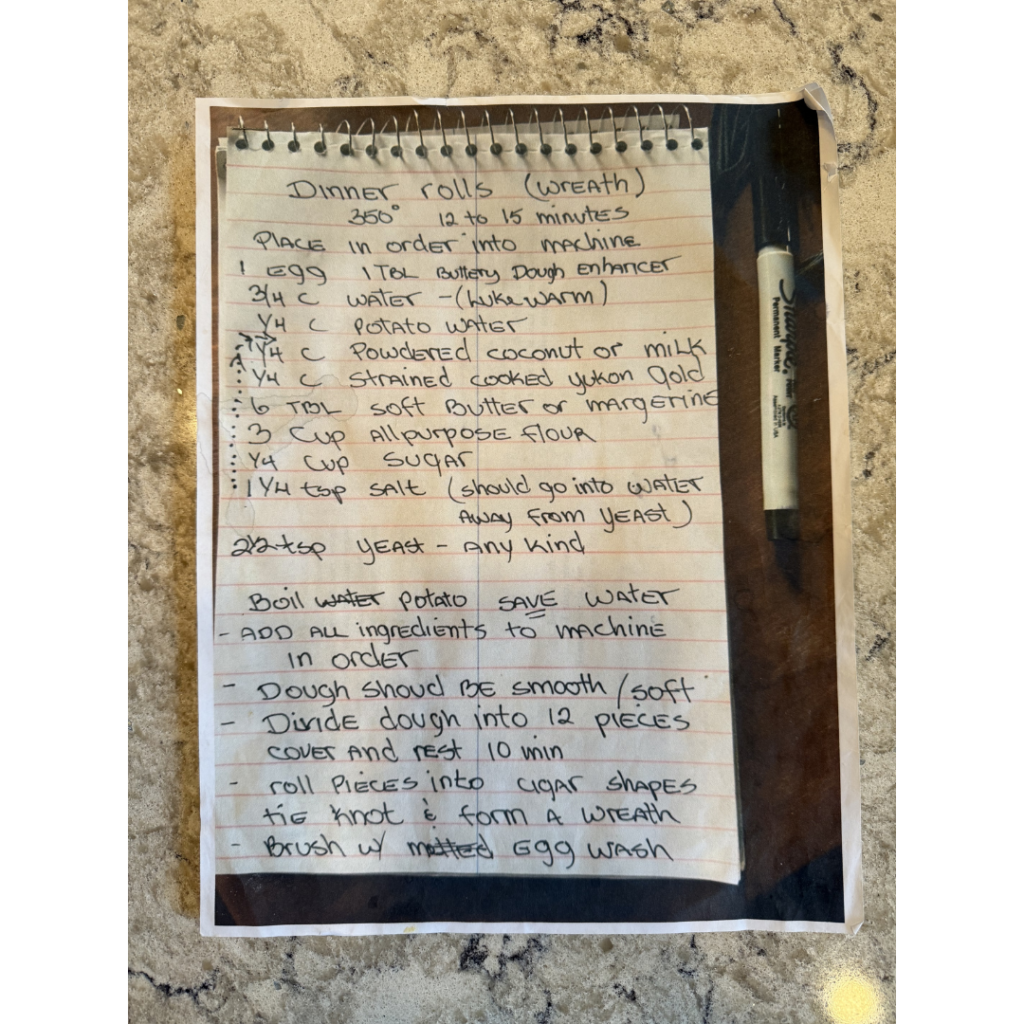

Note: The photos below feature the recipe that uses a bread machine.
I don’t know about you, but I love cooking and baking around the holidays. Of course, trying a new recipe is exciting, but making this bread wreath recipe is extra special. I get super nostalgic year after year and gathering after gathering that I make it.
There’s something about making bread that makes you feel present and thankful. And then to see the delight on people’s faces when they see this special bread wreath? It’s a real treat!
I hope this easy bread wreath recipe becomes a tradition in your home. From my table to yours, I hope you enjoy this recipe as much as I do.
A few ways to enjoy this bread wreath
- On their own, slathered with butter, of course.
- Place a wheel of brie in the center and top it with fresh pomegranate and drizzled honey.
- Buns for the absolute easiest and best pulled pork sandwiches (recipe by Lily Nichols)
- If you end up with leftovers, use these for any kind of sandwich.
- I like to make a simple ham, cheese, arugula, and mustard sandwiches.
- Turkey, Swiss cheese, and cranberry sauce.
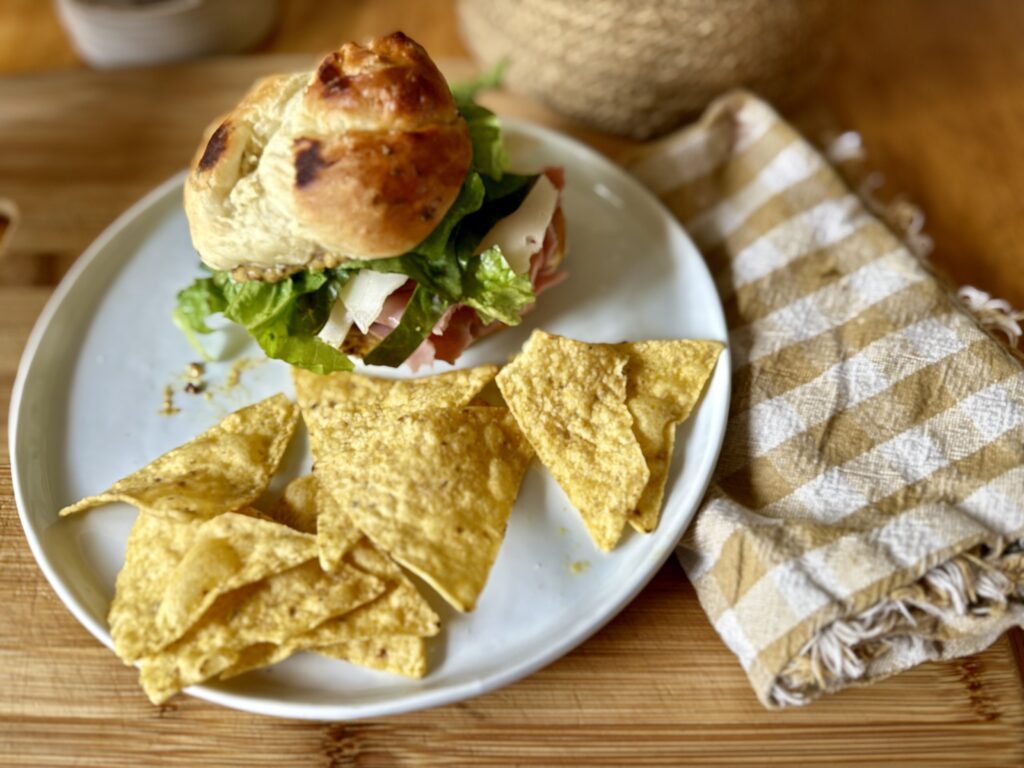
Helpful tips
At first glance, this easy bread wreath recipe might not look so easy, but I promise it is! Just take it step by step. Also, I’ve added plenty of photos for you to refer to.
There are two recipe variations are included in this post:
- The first recipe variation is to make the bread wreath by hand.
- The other recipe variation involves using a bread machine.
Using a bread machine is a little more simple because you throw everything in and let the machine do its thing to prepare the dough. But, once the dough is prepared, the steps are the same regardless of which variation you use to make the bread wreath.
And, if you are pressed for a large chunk of time, this recipe can be broken up into two days. You can read how to do that in the Frequently Asked Questions.
Items you’ll need:
- Measuring spoon
- Measuring cups
- Wooden spoon
- Spatula
- Bench scraper
- Small mixing bowl
- Large mixing bowl
- Hand mixer
- Parchment paper
- Circle pizza stone (Any circular baking sheet will do. I’ve tried using a cookie sheet, but it’s not big enough to make a circle.)
- Silicone pastry brush
Easy Bread Wreath Recipe:
- 1 medium Yukon Gold potato
- 3/4 cup lukewarm water
- 2 1/2 teaspoons active dry yeast
- 1 1/4 teaspoons of coarse salt plus more for sprinkling on top of rolls (or this rosemary sea salt)
- 3 cups all-purpose flour
- 1/4 cup powdered buttermilk
- 6 tablespoons of softened unsalted butter
- 1/4 cup sugar
- 1 tablespoon buttery dough enhancer
- 2 egg – 1 egg for dough and 1 for egg wash
- Rosemary sprigs for 2-3 heaping tablespoons
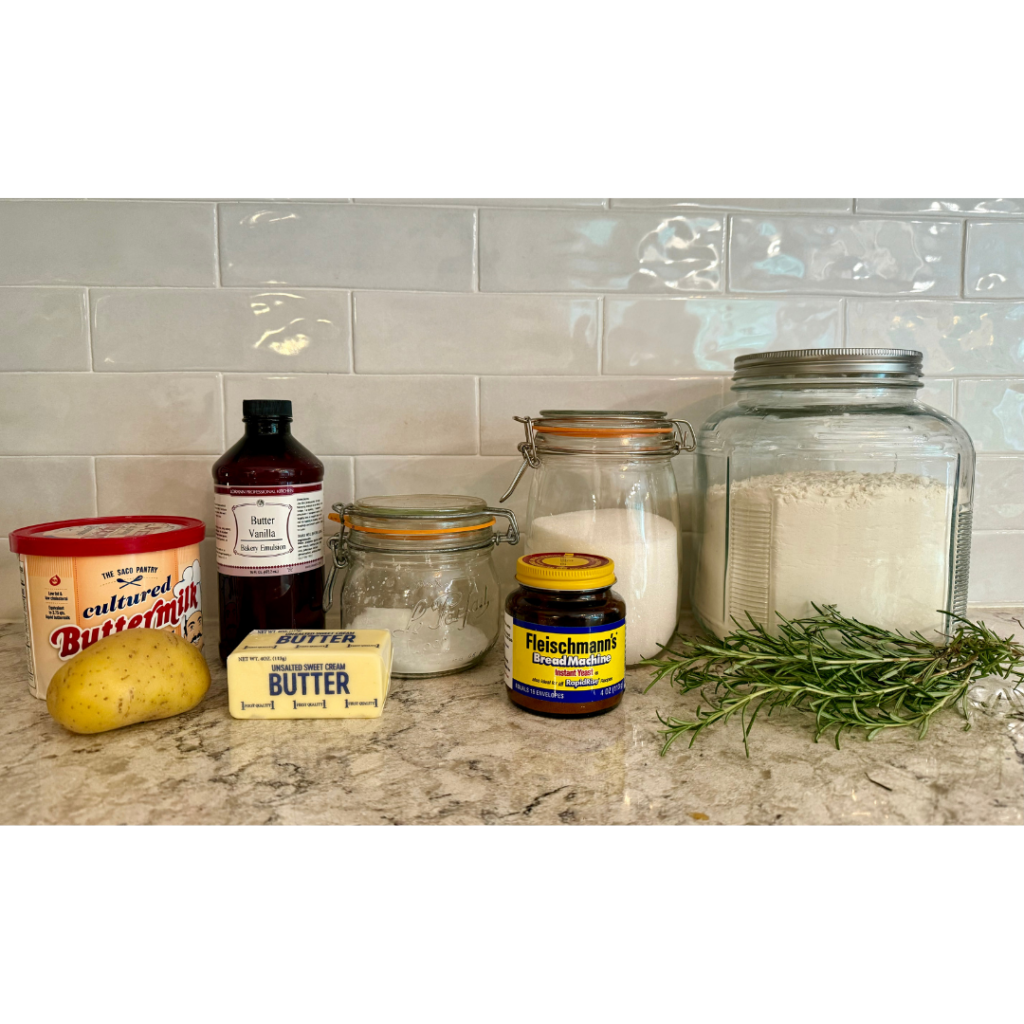
Steps if you’re making bread wreath by hand:
Step 1: Peel and quarter Yukon potato.
Step 2: Place potato in a small saucepan, and cover with water. Bring to a rolling boil, and cook until the potato is fork tender. About 15 minutes. What does fork tender mean? Poke your potato with a fork. Does it easily poke into the potato and pull away without resistance? If yes, then this is fork tender. If not, let it boil a couple more minutes. Do not discard the potato water!
Step 3: Separate water and potato and set both aside to cool. Don’t forget to keep the potato water!
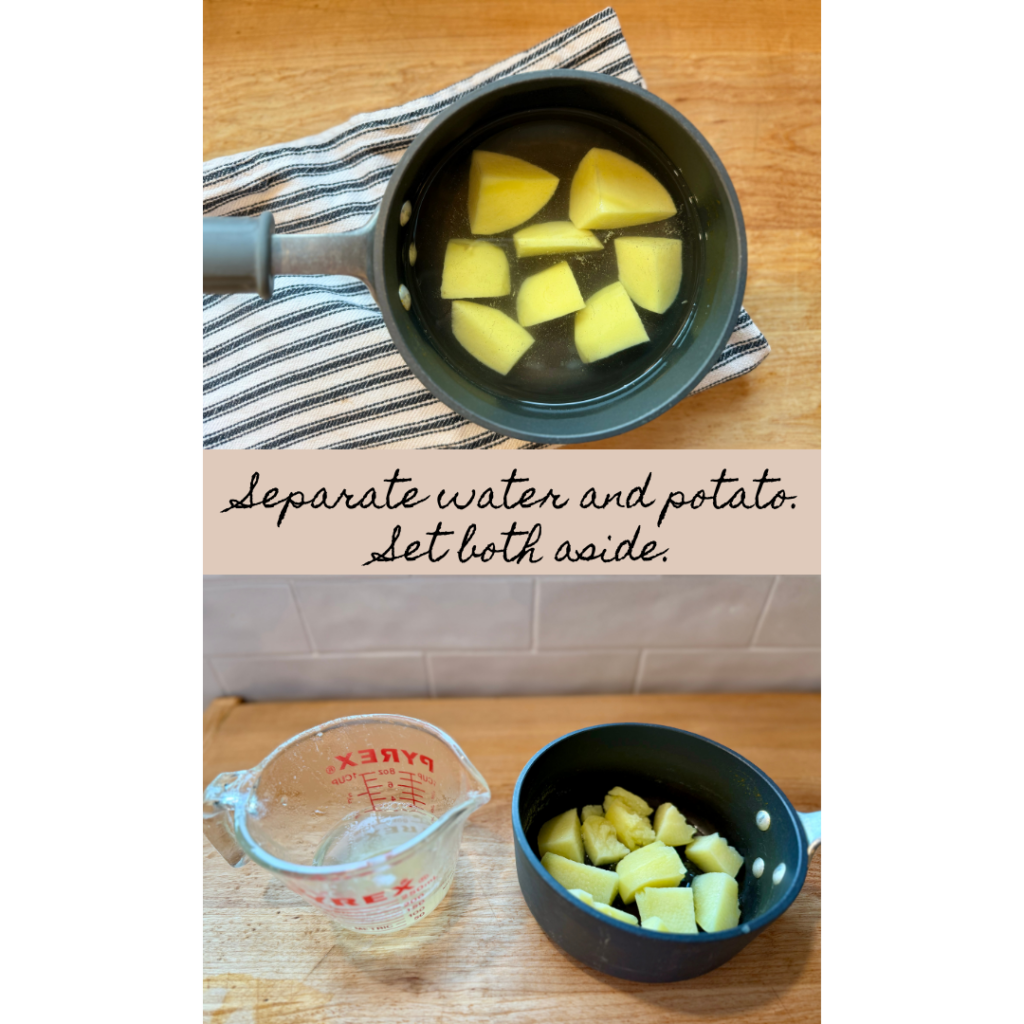
Step 4: Next, prepare yeast. Whisk 3/4 cup lukewarm water with 2 1/2 heaping teaspoons of active dry yeast until well combined. Set aside in a place that is room temperature/warm and until frothy foam forms on the top of your mixture. This would take 5-10 minutes. If your yeast didn’t foam, check the FAQs below for troubleshooting.
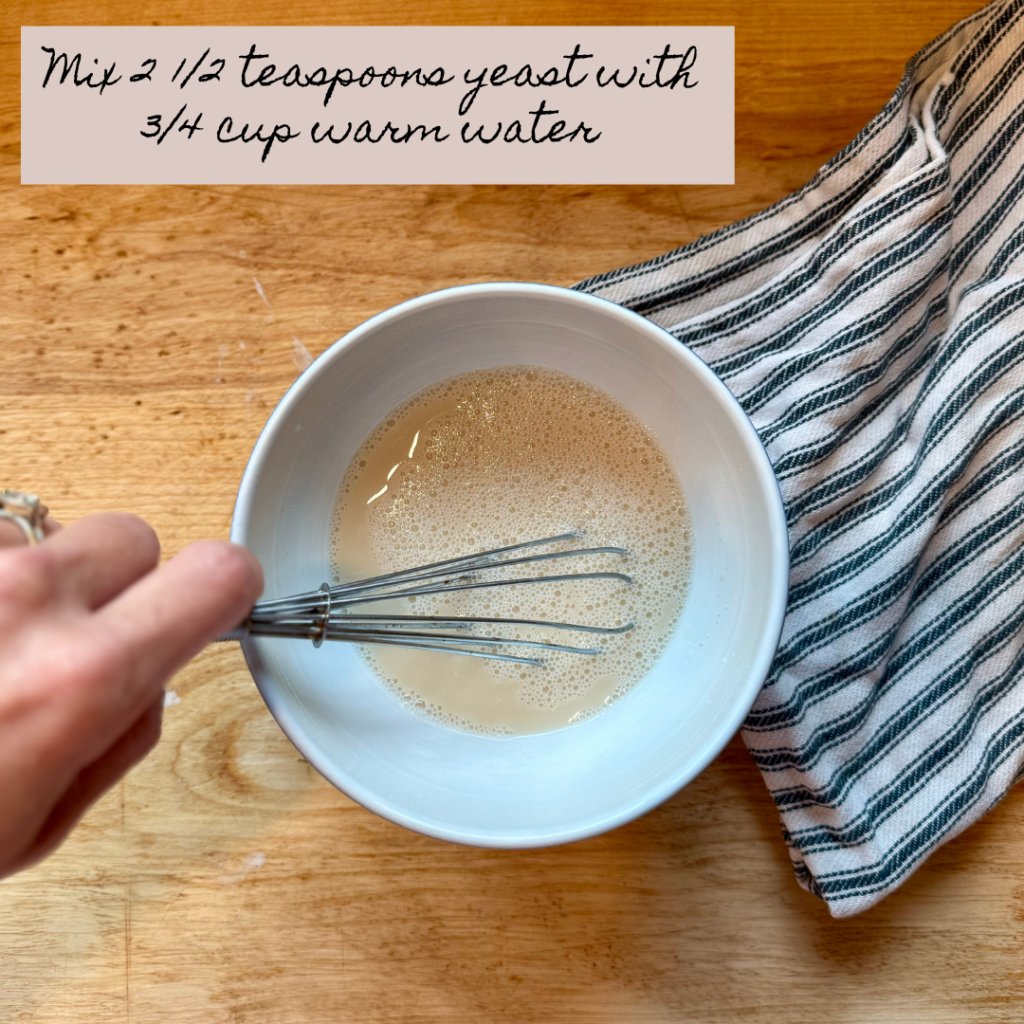
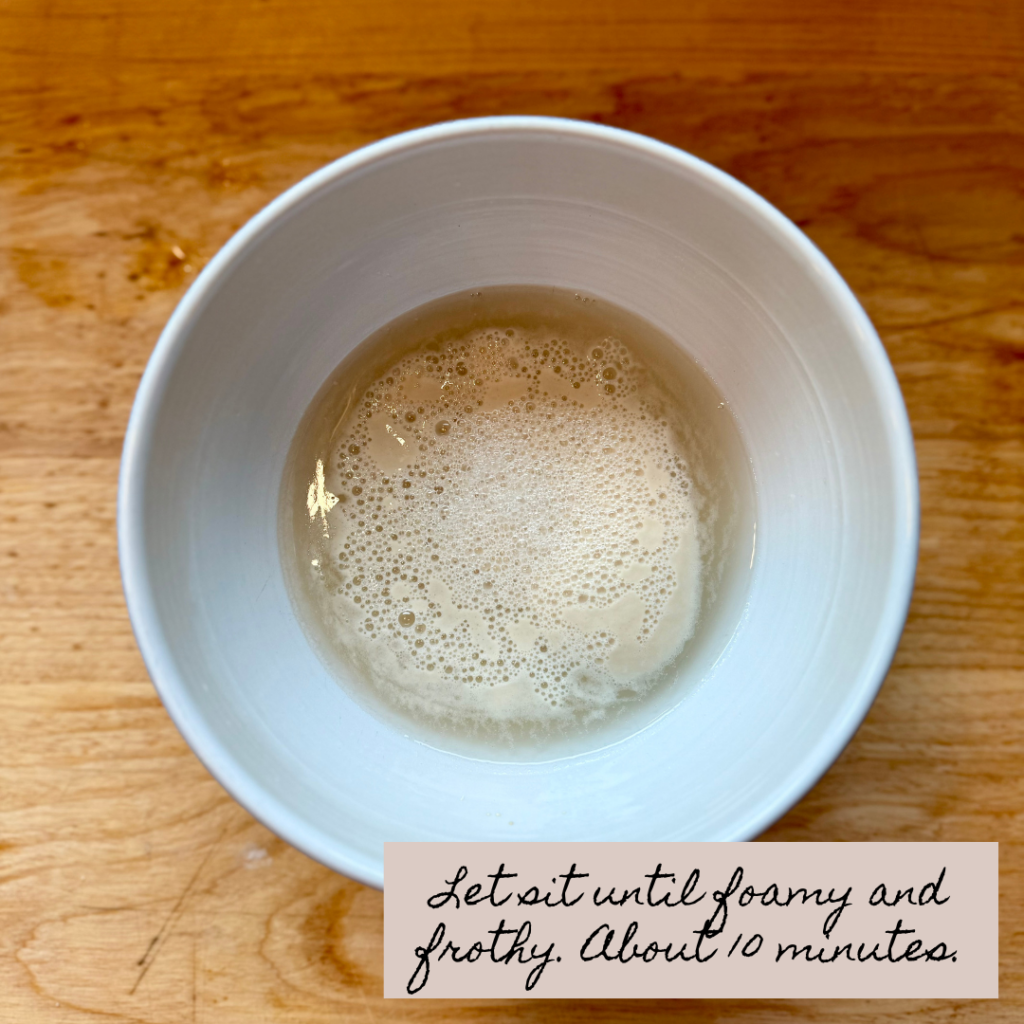
Step 5: Prepare dry ingredients. In a medium bowl, use a wooden spoon to mix 3 cups of all-purpose flour, 1/4 cup powdered buttermilk, and 1 1/4 teaspoons of salt. Set aside.
Step 6: Prepare wet ingredients. In a large bowl, cream 6 tablespoons of butter with a hand mixer on medium speed. Add 1 egg, 1/4 cup sugar, 1 tablespoon of dough enhancer, and 1/4 of reserved potato water. Blend until it’s just combined.
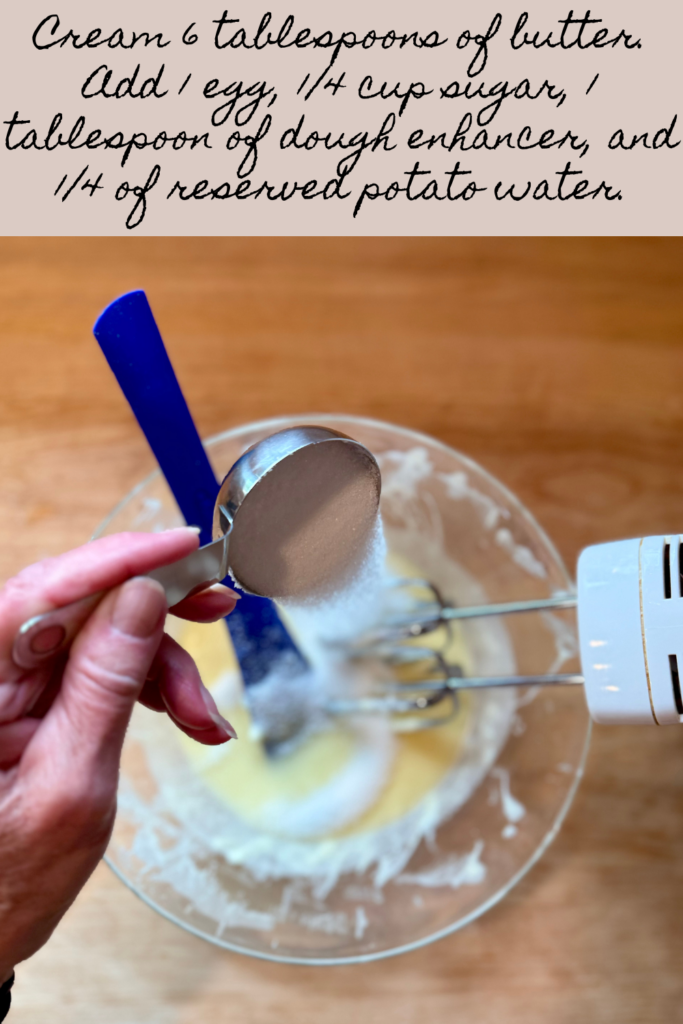
Step 7: Lightly mash 1/4 cup potato. Add potato to a large bowl with wet ingredients and mix until just combined.
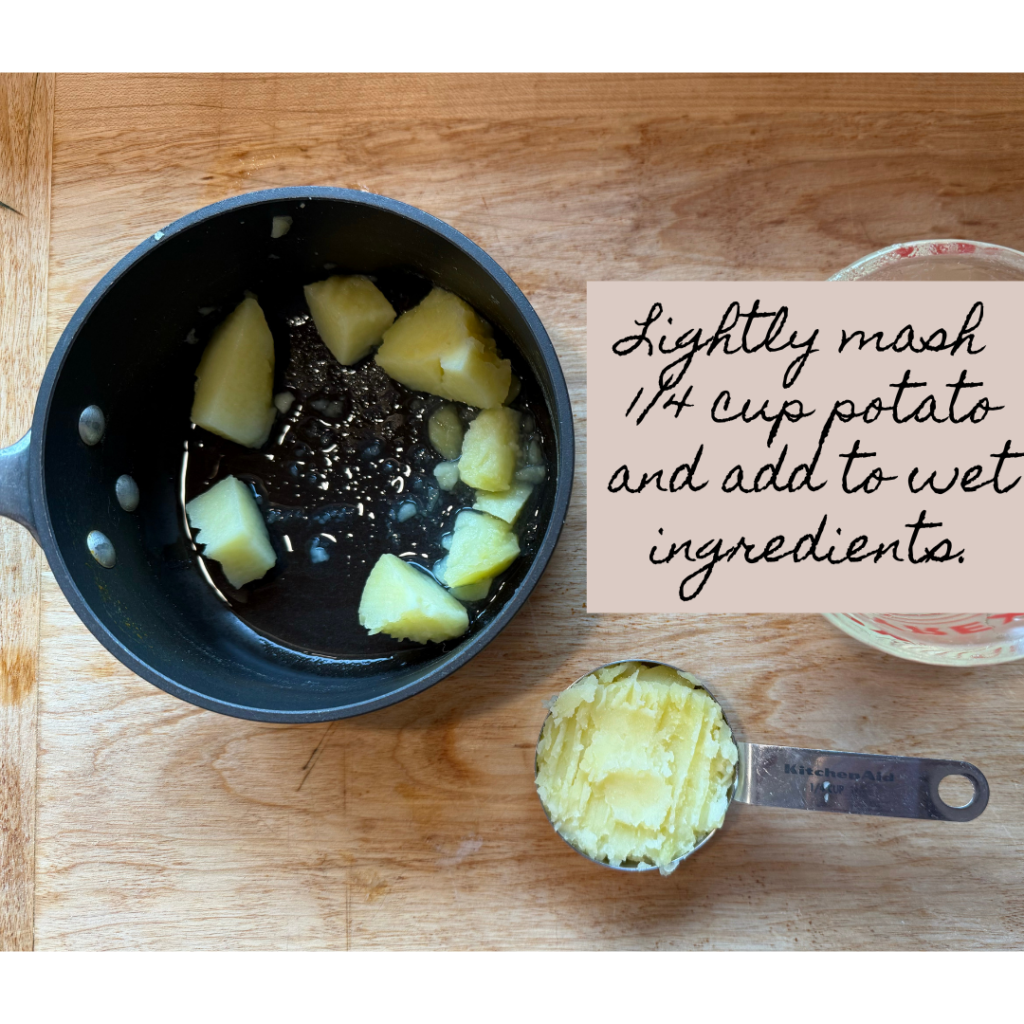
Step 8: Add yeast mixture into wet ingredients, and gently stir with a wooden spoon.
Step 9: Next, add half of your dry ingredients to your wet ingredients and gently mix. Once ingredients are mostly combined (it’s okay if there are lumps), add the second half of your dry ingredients and gently mix with a wooden spoon.
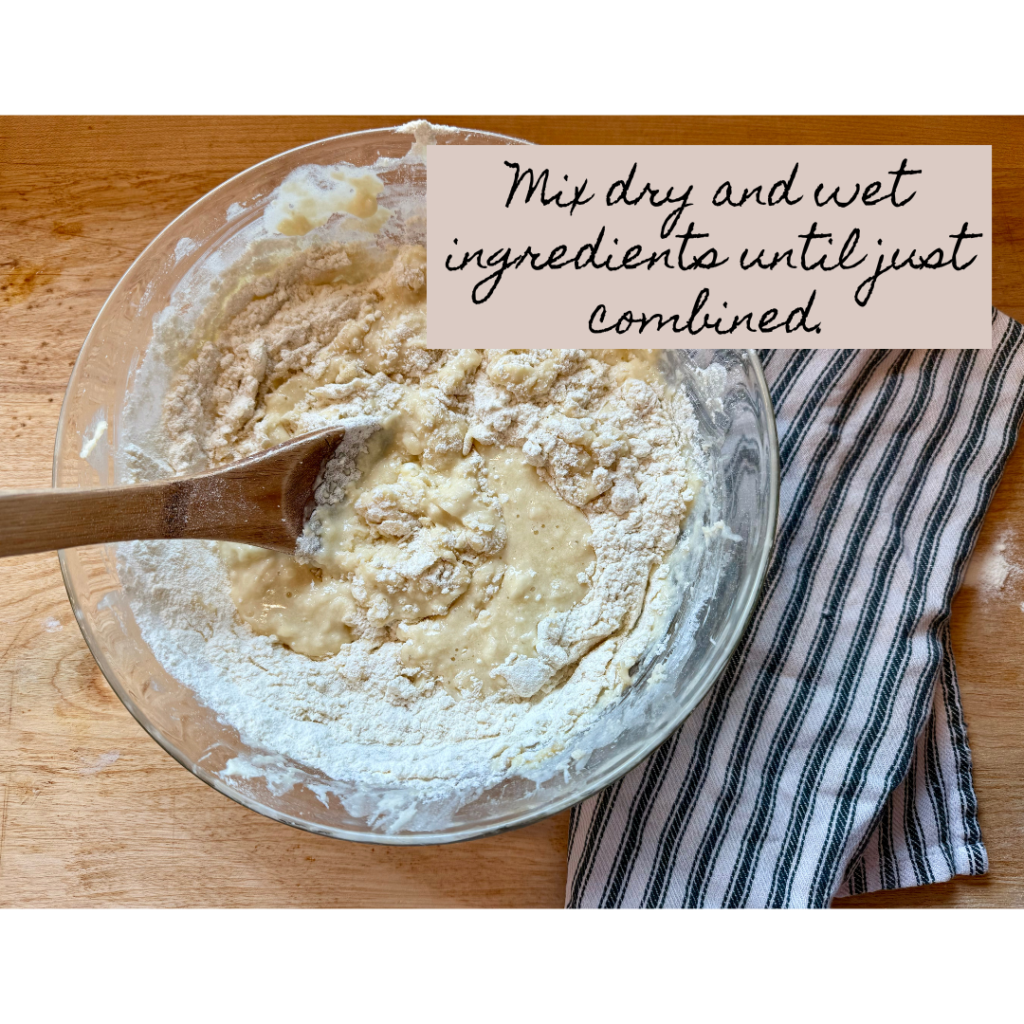
Step 10: Gently turn dough mixture onto lightly floured surface. Knead until dough is smooth and soft. Note: The dough will be sticky at first so sprinkle flour as needed to your surface so the dough doesn’t stick.
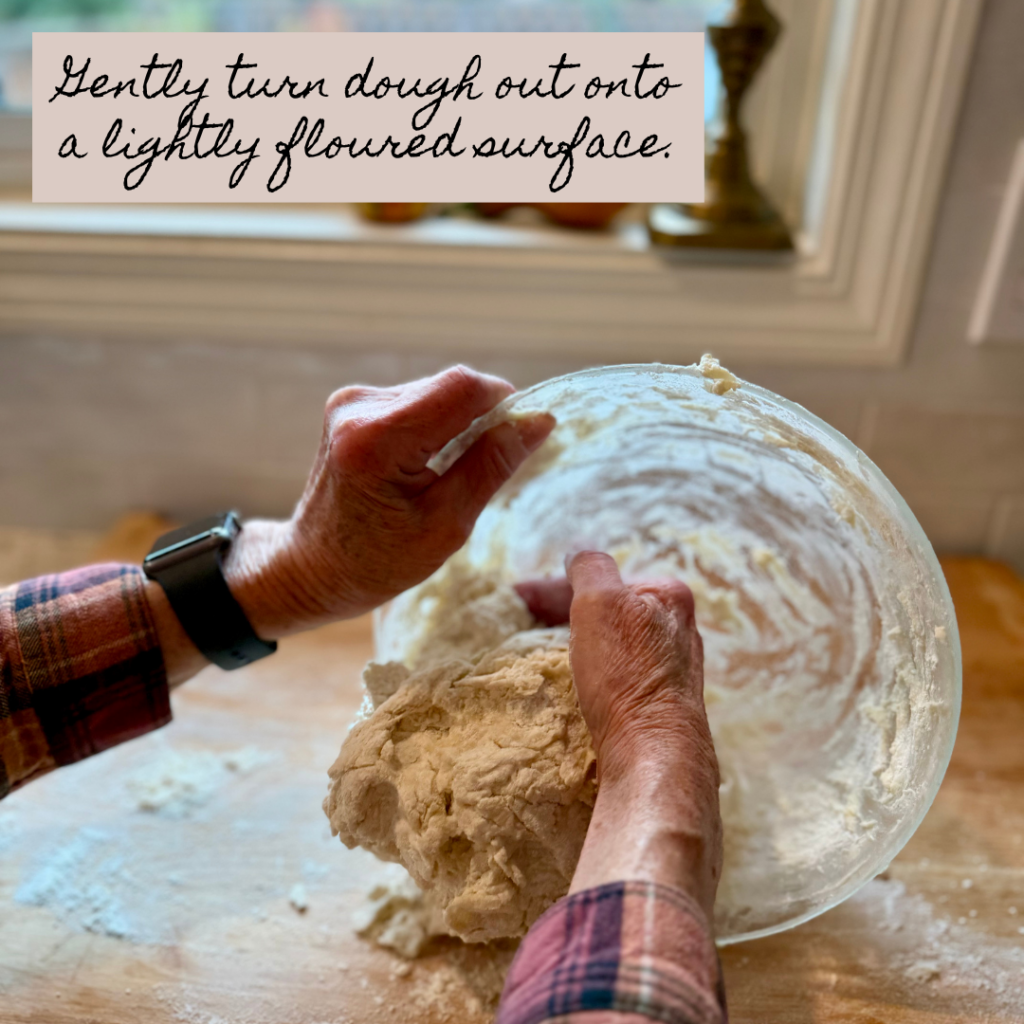
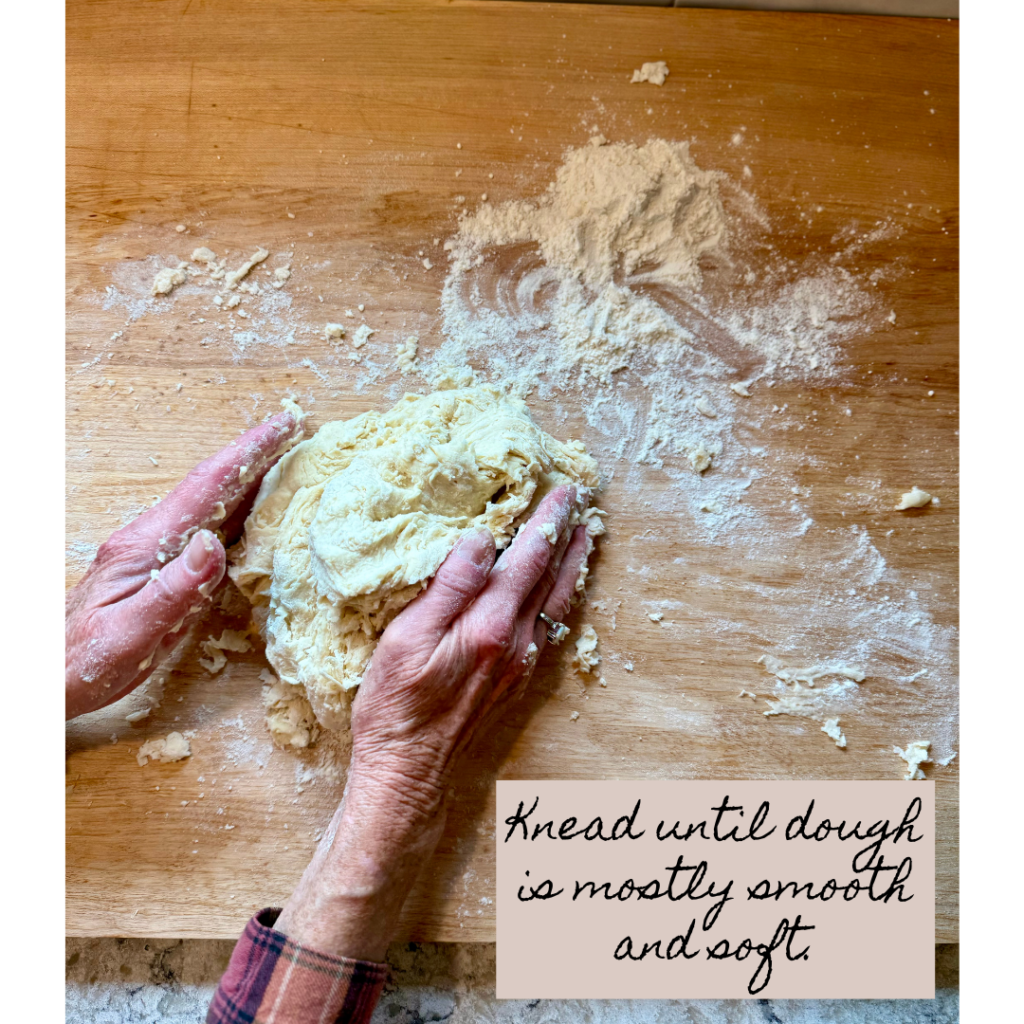
Step 11: To ensure the dough is ready, perform the window pane test. To do this, grab a walnut-size piece, stretch enough to see light through it without breaking. If your dough breaks or you can’t see light pass through, knead some more.
Step 12: Return dough to mixing bowl, cover, and let rise in warm, dry place (I like to place mine in my microwave with the door open) until dough has increased 1.5 times in bulk. Approximately 45 minutes-2 hours.
Step 13: Once dough has risen, punch the center of the dough down in a bowl. Then gently turn dough out on a lightly floured surface.
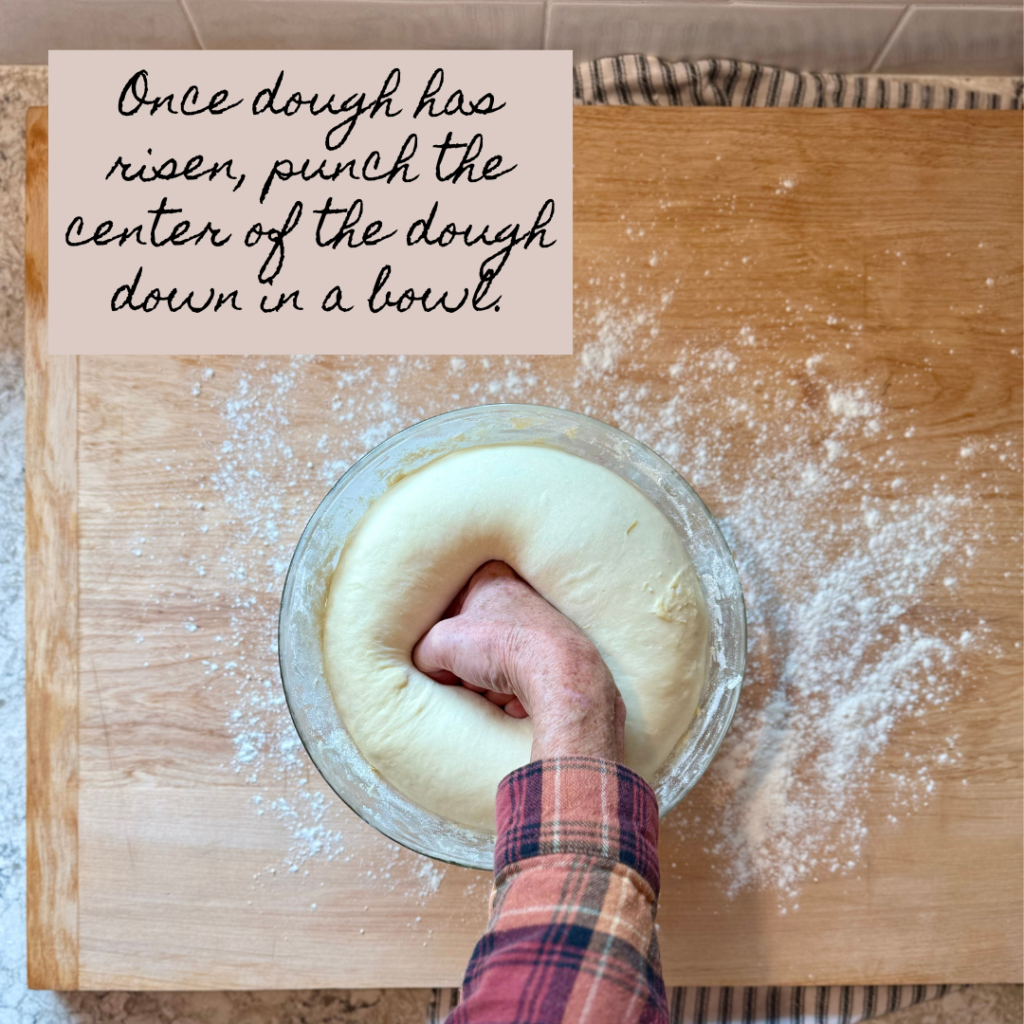
Step 14: Using your bench scraper, divide dough into 12 pieces. Cover with a dish towel and let rest for 10 minutes.
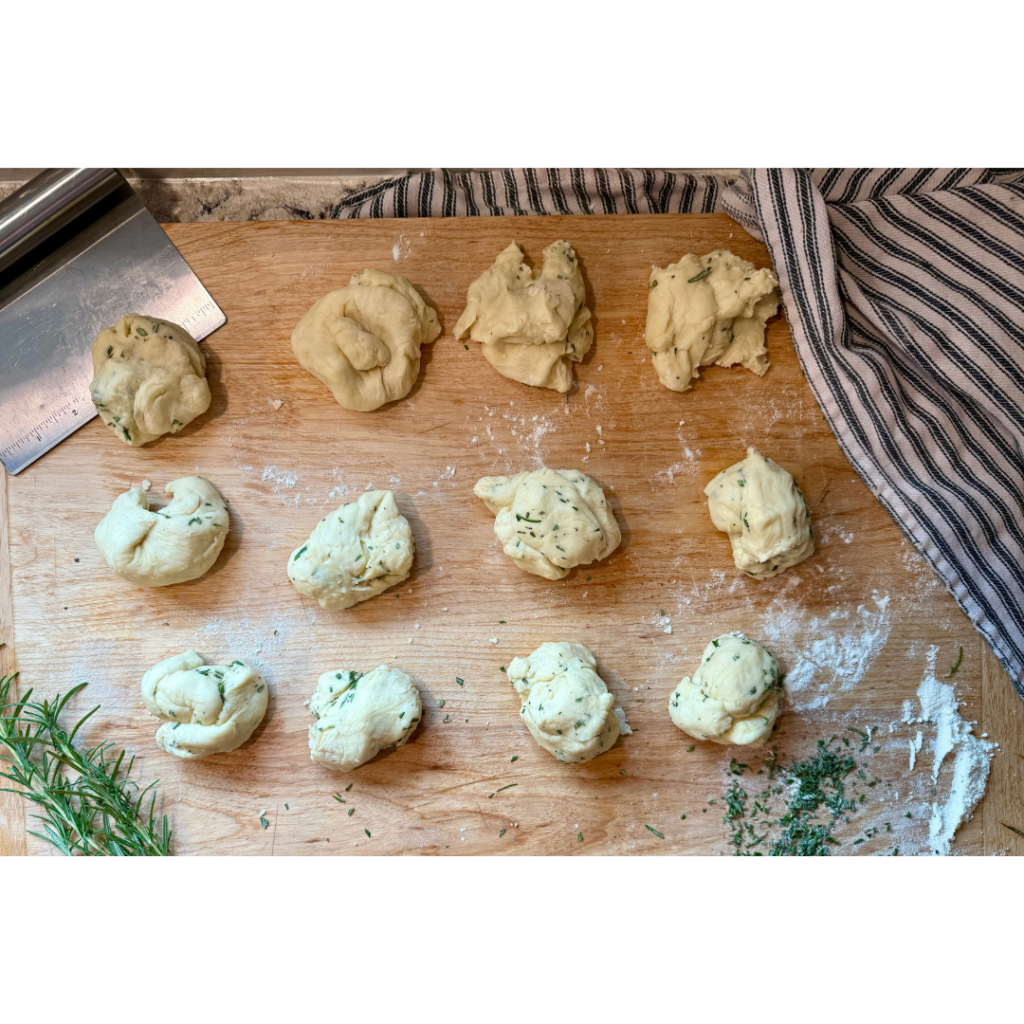
Step 15: While the dough is resting, mince 2-3 tablespoons of rosemary.
Step 16: Next, sprinkle rosemary and roll dough pieces into approximately 10 inch long cigar shapes. To do this, roll dough out on a lightly floured surface, starting from the middle and rolling out. After you’ve rolled your dough into a cigar shape, take both ends, twist, and tie a knot.
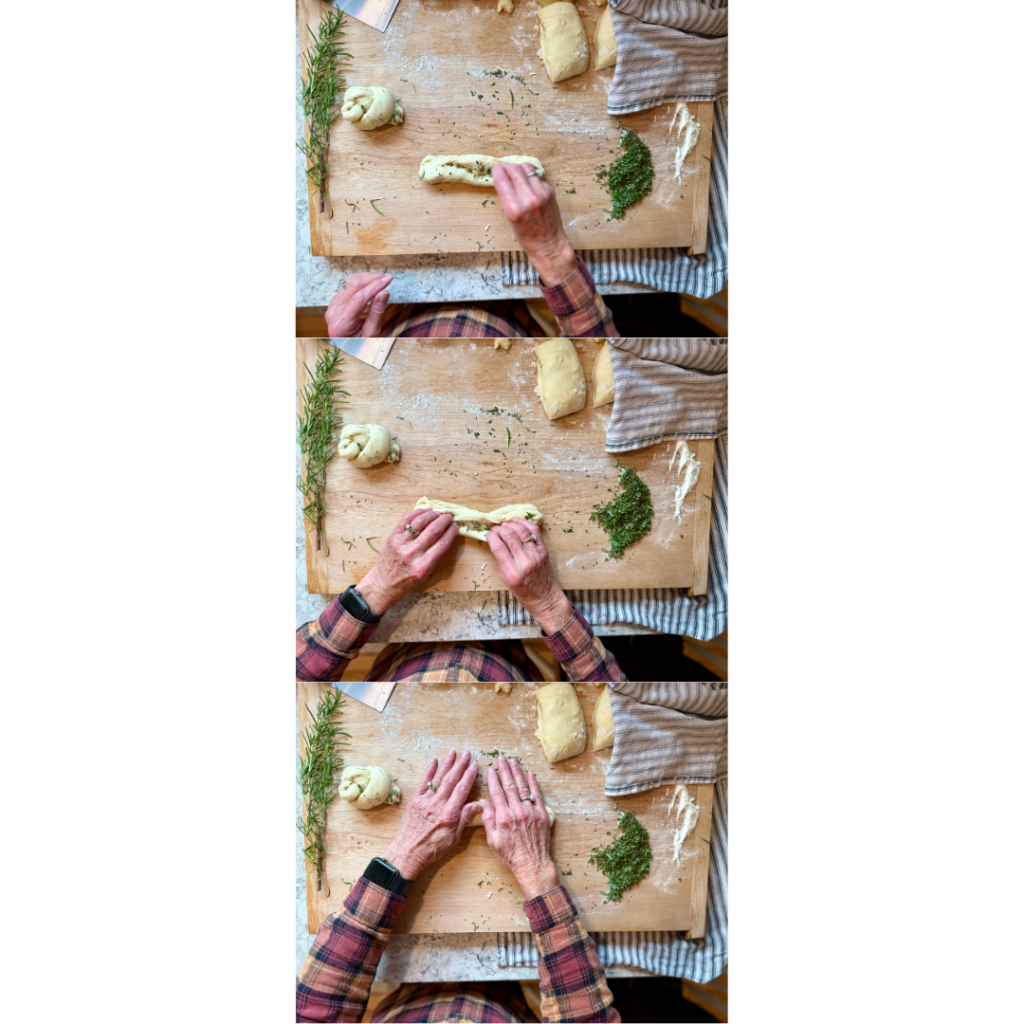
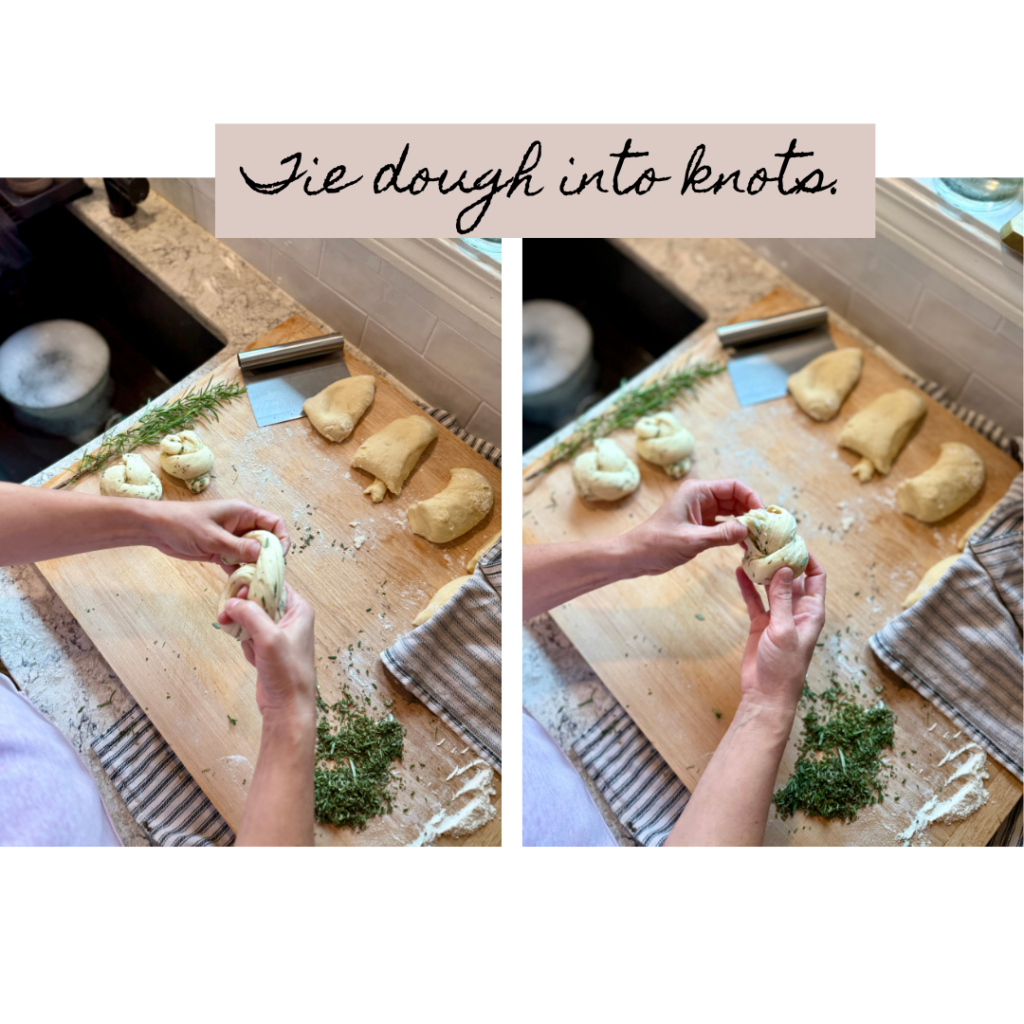
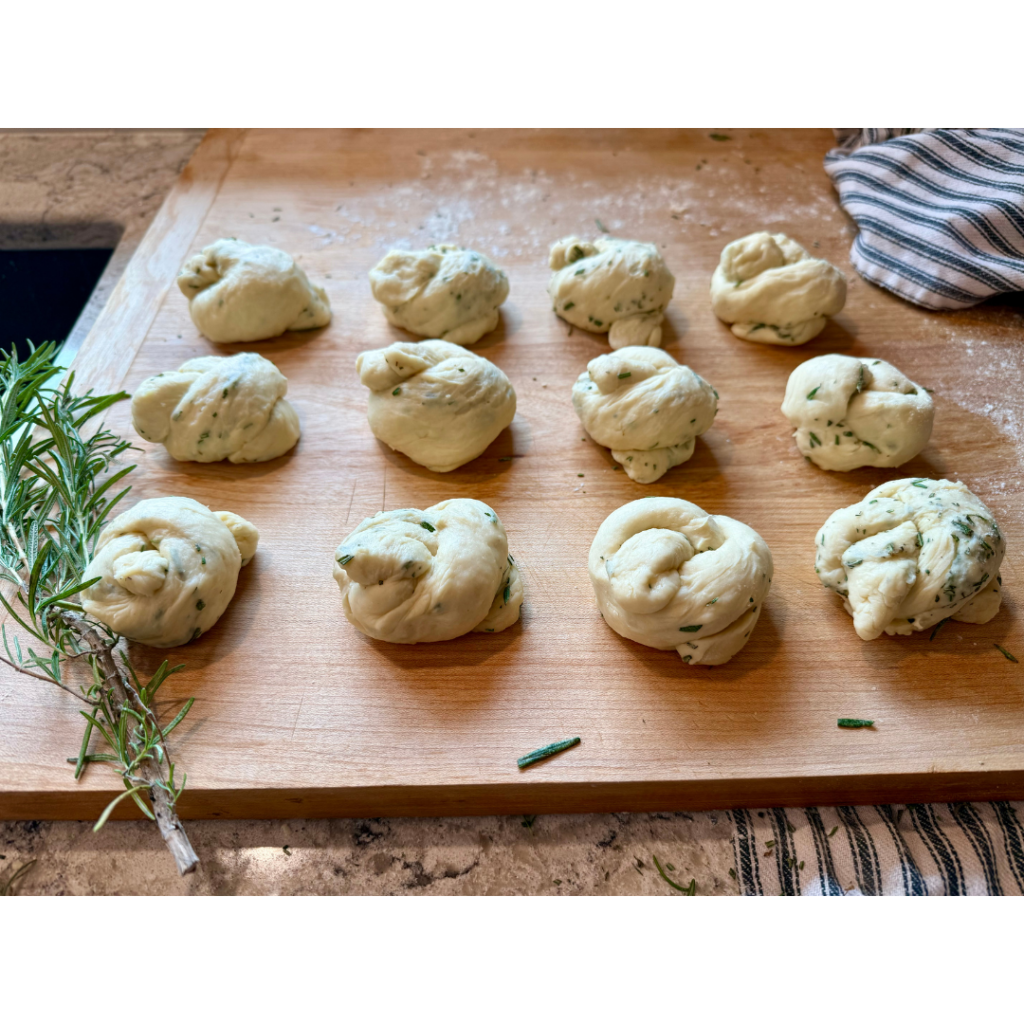
Step 17: Now, you’re going to place dough knots on a circular pizza stone and let rise for 30 minutes to 1 hour. You want your rolls to be puffy and touching or almost touching. Note: To help evenly space your rolls, I recommend imaging a clock and start with placing rolls at 12, 3, 6, and 9 o’clock. Then fill in the rest of dough knots to form the bread wreath.
Step 18: Meanwhile, preheat oven to 350 F. Make egg wash. To do this, whisk 1 egg in a small bowl. Use a silicone pastry brush to apply a generous amount of egg. Top with coarse salt.
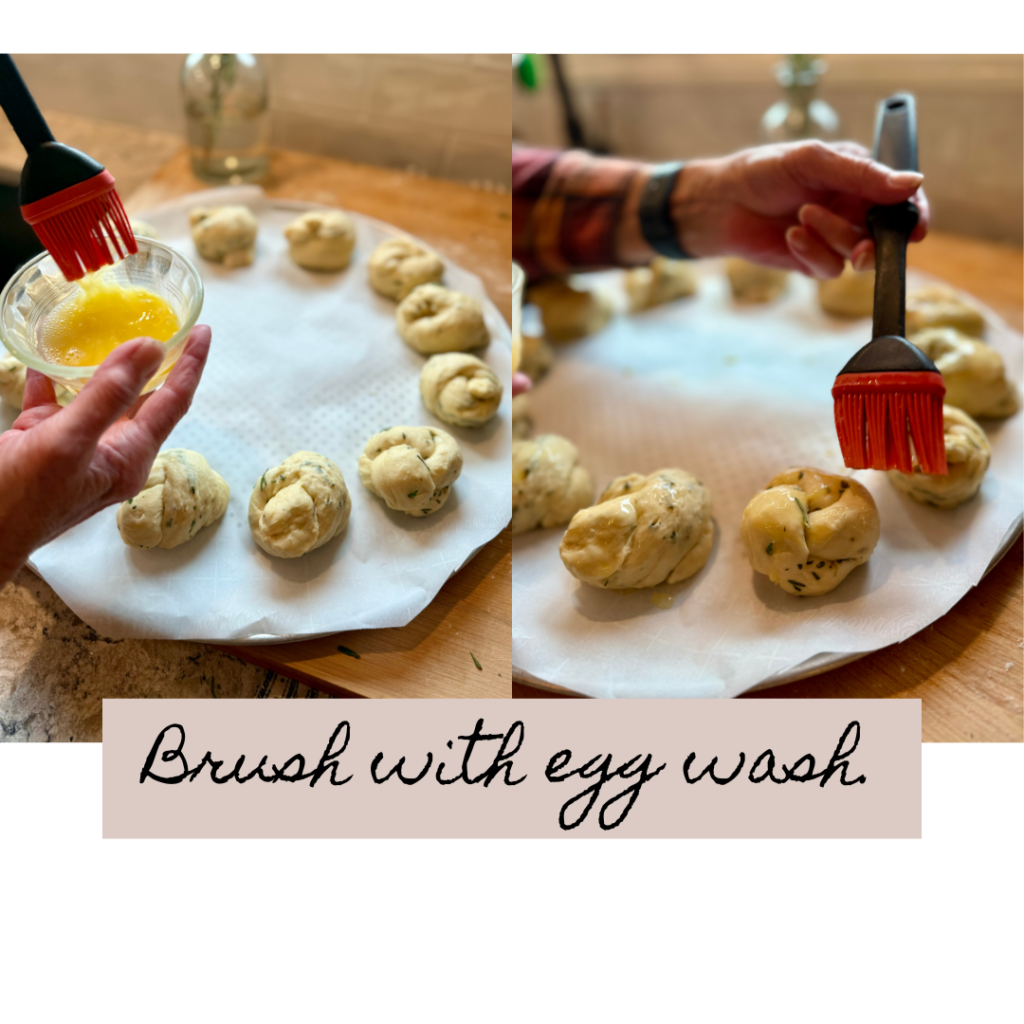
Step 18: Bake for about 15 minutes or until golden brown. Note: If you plan on eating this later, you can always partially bake them for 10 minutes and then bake them for another 5 minutes right before you’re ready to eat.
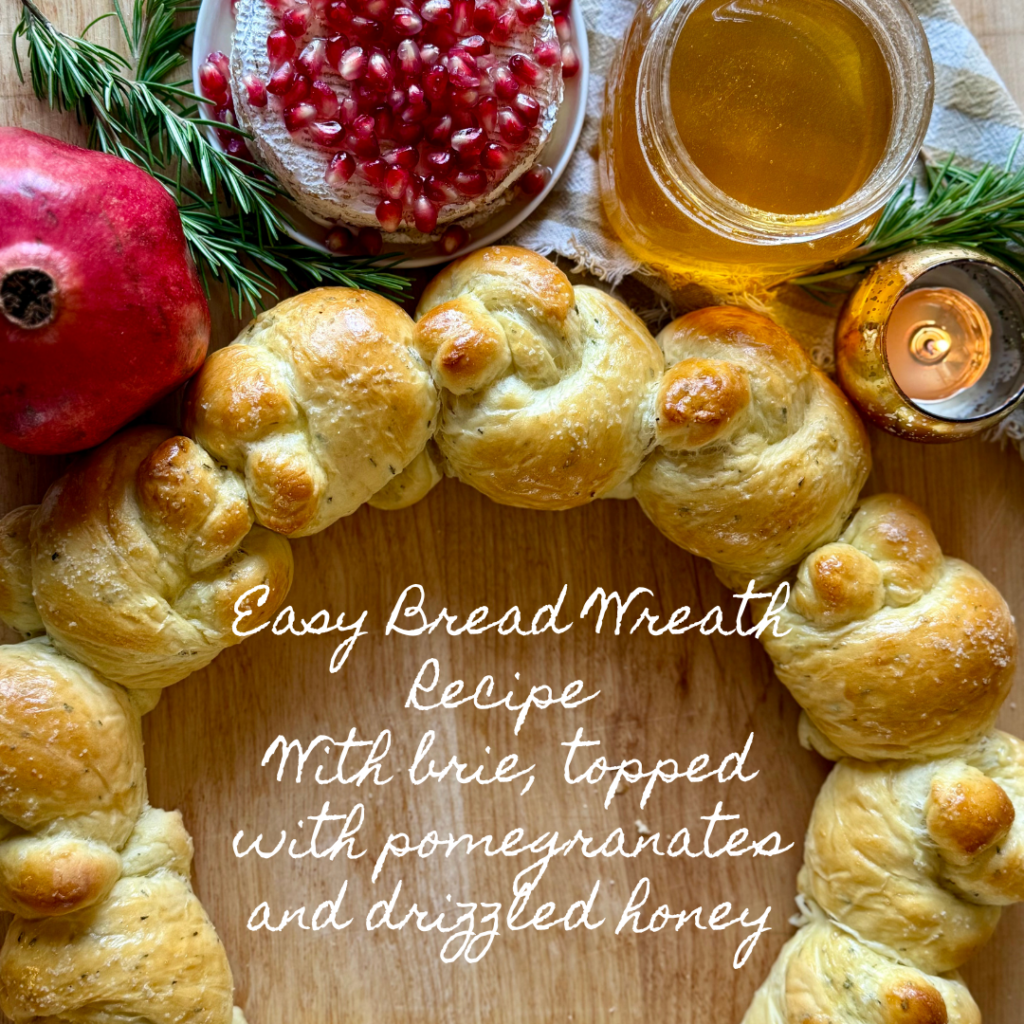
How to make this bread wreath using a bread machine
Step 1: Peel and quarter Yukon potato.
Step 2: Place potato in a small saucepan. Cover with water, bring to a rolling boil, and cook until the potato is fork tender. About 15 minutes. What does fork tender mean? Poke your potato with a fork. Does it easily poke into the potato and pull away without resistance? If yes, then this is fork tender. If not, let it boil a couple more minutes. Do not discard the potato water!
Step 3: Separate water and potato and set both aside to cool. Don’t forget to keep the potato water!
Step 4: Lightly mash 1/4 cup potato.
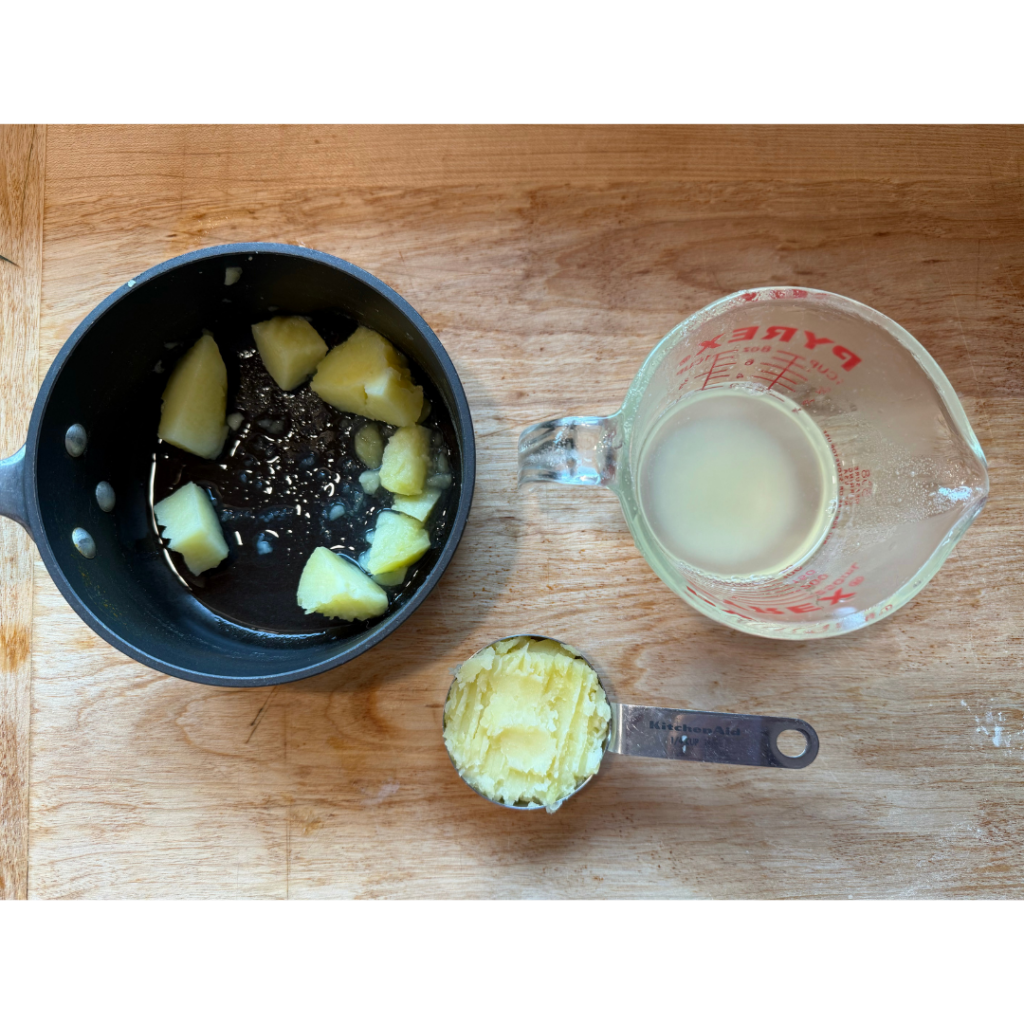
Step 5: Place the following ingredients in order into your bread machine:
- 1 egg
- 1 tablespoon buttery dough enhancer
- 3/4 cup lukewarm water
- 1/4 cup potato water
- 1 1/4 teaspoon salt (salt should go in away from yeast because salt acts as a yeast inhibitor)
- 1/4 cup powdered buttermilk
- 1/4 cup lightly mashed Yukon gold potato
- 6 tablespoons softened unsalted butter
- 3 cups all-purpose flour
- 1/4 cup sugar (placing sugar next to yeast helps activate the yeast)
- 2 1/2 teaspoon yeast
Step 6: After bread machine has completed cycle, see Step 12 above and follow along for rest of recipe.
Print this recipe!

Easy Bread Wreath With Rosemary and Sea Salt
This easy-to-follow bread wreath recipe will be a showstopper this holiday season! This recipe makes the fluffiest rolls in the world. Each pillowy bite is the right amount of salty and hints of rosemary. They can be enjoyed on their own (slathered with butter, of course) or you can place a wheel of brie in the center and top it with fresh pomegranate and drizzled honey. If you end up with leftovers, these make the simple ham, cheese, arugula, and mustard sandwiches that are to die for.
Ingredients
- 1 medium Yukon Gold potato
- 3/4 cup lukewarm water
- 2 1/2 teaspoons active dry yeast
- 1 1/4 teaspoons of coarse salt plus more for sprinkling on top of rolls
- 3 cups all-purpose flour
- 1/4 cup powdered buttermilk
- 6 tablespoons of softened unsalted butter
- 1/4 cup sugar
- 1 tablespoon buttery Dough enhancer
- 2 egg - 1 egg for dough and 1 for egg wash
- Rosemary sprigs for 2-3 heaping tablespoons
Instructions
Step 1: Peel and quarter Yukon potato.
Step 2: Place potato in a small saucepan, and cover with water. Bring to a rolling boil, and cook until the potato is fork tender. About 15 minutes. What does fork tender mean? Poke your potato with a fork. Does it easily poke into the potato and pull away without resistance? If yes, then this is fork tender. If not, let it boil a couple more minutes. Do not discard the potato water!
Step 3: Separate water and potato and set both aside to cool. Don't forget to keep the potato water!
Step 4: Next, prepare yeast. Whisk 3/4 cup lukewarm water with 2 1/2 heaping teaspoons of active dry yeast until well combined. Set aside in a place that is room temperature/warm and until frothy foam forms on the top of your mixture. This would take 5-10 minutes.
Step 5: Prepare dry ingredients. In a medium bowl, use a wooden spoon to mix 3 cups of all-purpose flour, 1/4 cup powdered buttermilk, and 1 1/4 teaspoons of salt. Set aside.
Step 6: Prepare wet ingredients. In a large bowl, cream 6 tablespoons of butter with a hand mixer on medium speed. Add 1 egg, 1/4 cup sugar, 1 tablespoon of dough enhancer, and 1/4 of reserved potato water. Blend until it's just combined.
Step 7: Lightly mash 1/4 cup potato. Add potato to a large bowl with wet ingredients and mix until just combined.
Step 8: Add yeast mixture into wet ingredients, and gently stir with a wooden spoon.
Step 9: Next, add half of your dry ingredients to your wet ingredients and gently mix. Once ingredients are mostly combined (it's okay if there are lumps), add the second half of your dry ingredients and gently mix with a wooden spoon.
Step 10: Gently turn dough mixture onto lightly floured surface. Knead until dough is smooth and soft. Note: The dough will be sticky at first so sprinkle flour as needed to your surface so the dough doesn't stick.
Step 11: To ensure the dough is ready, perform the window pane test. To do this, grab a walnut-size piece, stretch enough to see light through it without breaking. If your dough breaks or you can't see light pass through, knead some more.
Step 12: Return dough to mixing bowl, cover, and let rise in warm, dry place (I like to place mine in my microwave with the door open) until dough has increased 1.5 times in bulk. Approximately 45 minutes-2 hours.
Step 13: Once dough has risen, punch the center of the dough down in a bowl. Then gently turn dough out on a lightly floured surface.
Step 14: Using your bench scraperr, divide dough into 12 pieces. Cover with a dish towel and let rest for 10 minutes.
Step 15: While the dough is resting, mince 2-3 tablespoons of rosemary.
Step 16: Next, sprinkle rosemary and roll dough pieces into approximately 10 inch long cigar shapes. To do this, roll dough out on a lightly floured surface, starting from the middle and rolling out. After you've rolled your dough into a cigar shape, take both ends, twist, and tie a knot.
Step 17: Place dough knots on a circular pizza stone, and let rest for 30 minutes to 1 hour. You want your rolls to be puffy and touching or almost touching. Note: To help evenly space your rolls, I recommend imaging a clock and start with placing rolls at 12, 3, 6, and 9 o'clock. Then fill in the rest to form the bread wreath.
Step 18: Preheat oven to 350 F. Make egg wash. To do this, whisk 1 egg in a small bowl. Use a silicone pastry brush to apply a generous amount of egg. Top with coarse salt.
Enjoy!
Notes
Can I make my dough ahead of time? Or divide this recipe up into two days?
Yes! To do this, on day 1 complete steps 1-11 if you're making this bread wreath by hand, or steps 1-5 if you're using a bread machine. After that lightly flour your dough, cover in parchment paper, put in gallon ziplock bag and store in the refrigerator over night.
The next day take dough out, put on lightly floured surface for about an hour (so it's room temperature and soft and fluffy) then continue at step 12.
My yeast didn't foam. What should I do?
If your yeast doesn't foam after 10 ish minutes, discard and start over. Make sure the water you're using isn't too hot or cold (it needs to be lukewarm). Also, check that your yeast isn't expired. I like to store my yeast in the refrigerator to keep it fresh longer.
I don't have/like rosemary. Can I leave it out?
You betcha! I will say that I am horrible at gardening and rosemary is one of the things I can keep alive! If you love rosemary it may be worth planting a rosemary bush in your backyard.
Frequently Asked Questions
Can I make my dough ahead of time? Or divide this recipe up into two days?
Yes!
To do this, on day 1 complete steps 1-11 if you’re making this bread wreath by hand, or steps 1-5 if you’re using a bread machine. After that lightly flour your dough, cover in parchment paper, put in gallon ziplock bag and store in the refrigerator over night.
The next day take dough out of the refrigerator, put on lightly floured surface for about an hour (so it’s room temperature and soft and fluffy) then continue at step 12.
My yeast didn’t foam. What should I do?
If your yeast doesn’t foam after 10 ish minutes, discard and start over. Make sure the water you’re using isn’t too hot or cold (it needs to be lukewarm). Also, check that your yeast isn’t expired. I like to store my yeast in the refrigerator to keep it fresh longer.
I don’t have/like rosemary. Can I leave it out?
You betcha! I will say that I am horrible at gardening and rosemary is one of the things I can keep alive! If you love rosemary it may be worth planting a rosemary bush in your backyard.
Pin this post!
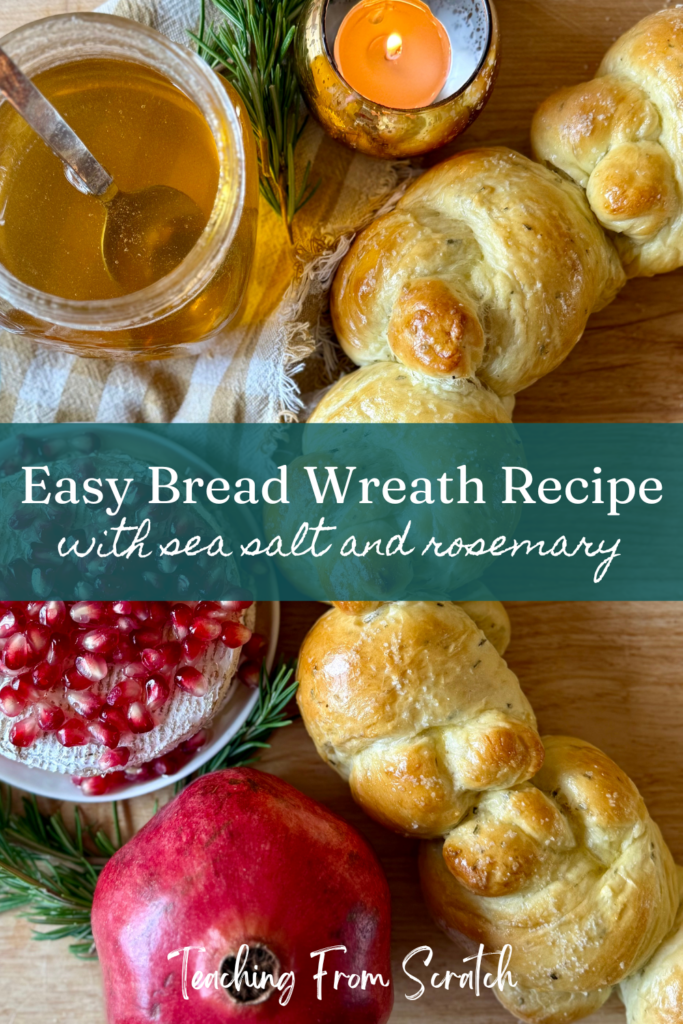


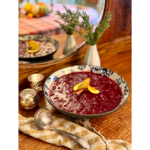


Leave a Reply